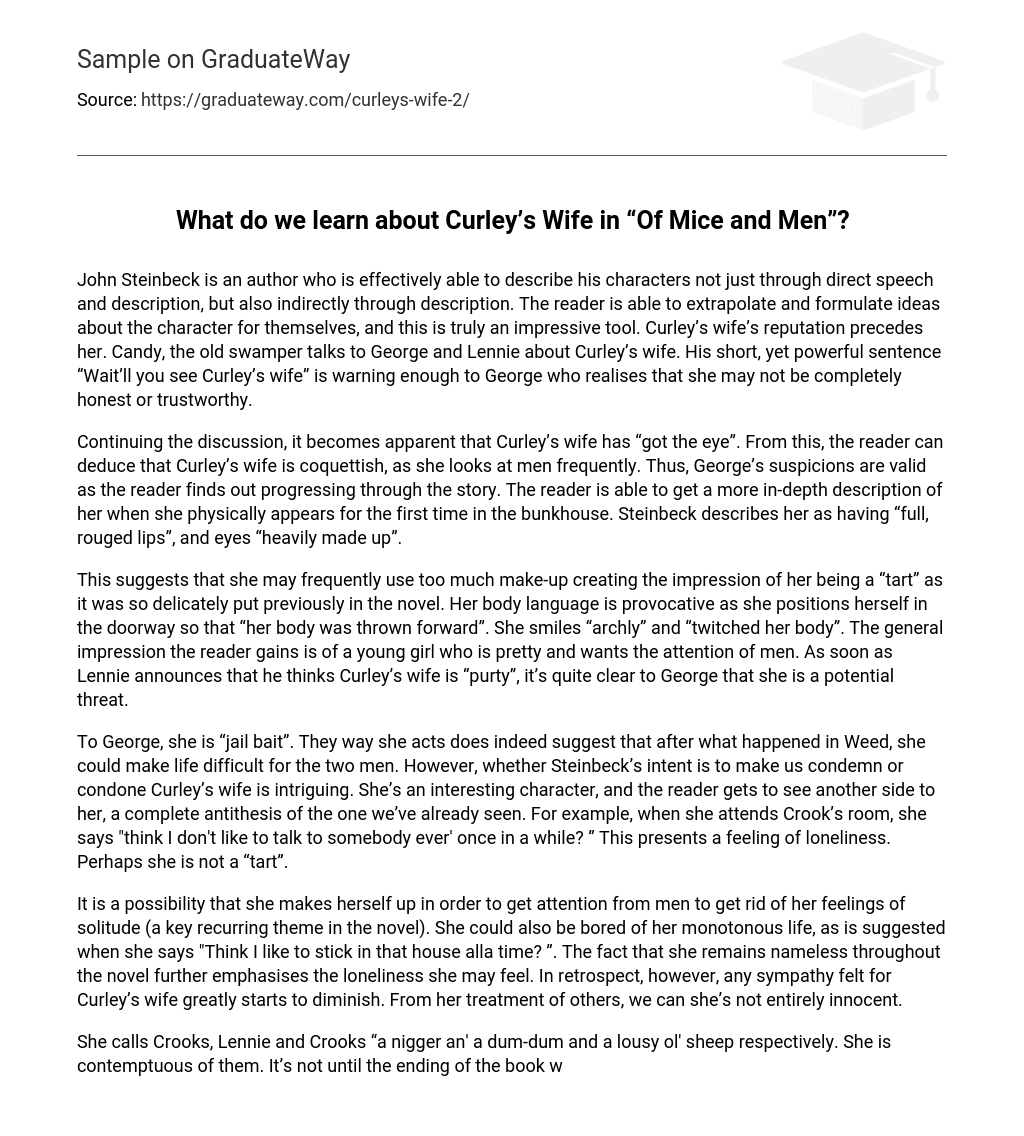John Steinbeck is an author who is effectively able to describe his characters not just through direct speech and description, but also indirectly through description. The reader is able to extrapolate and formulate ideas about the character for themselves, and this is truly an impressive tool. Curley’s wife’s reputation precedes her. Candy, the old swamper talks to George and Lennie about Curley’s wife. His short, yet powerful sentence “Wait’ll you see Curley’s wife” is warning enough to George who realises that she may not be completely honest or trustworthy.
Continuing the discussion, it becomes apparent that Curley’s wife has “got the eye”. From this, the reader can deduce that Curley’s wife is coquettish, as she looks at men frequently. Thus, George’s suspicions are valid as the reader finds out progressing through the story. The reader is able to get a more in-depth description of her when she physically appears for the first time in the bunkhouse. Steinbeck describes her as having “full, rouged lips”, and eyes “heavily made up”.
This suggests that she may frequently use too much make-up creating the impression of her being a “tart” as it was so delicately put previously in the novel. Her body language is provocative as she positions herself in the doorway so that “her body was thrown forward”. She smiles “archly” and “twitched her body”. The general impression the reader gains is of a young girl who is pretty and wants the attention of men. As soon as Lennie announces that he thinks Curley’s wife is “purty”, it’s quite clear to George that she is a potential threat.
To George, she is “jail bait”. They way she acts does indeed suggest that after what happened in Weed, she could make life difficult for the two men. However, whether Steinbeck’s intent is to make us condemn or condone Curley’s wife is intriguing. She’s an interesting character, and the reader gets to see another side to her, a complete antithesis of the one we’ve already seen. For example, when she attends Crook’s room, she says “think I don’t like to talk to somebody ever’ once in a while? ” This presents a feeling of loneliness. Perhaps she is not a “tart”.
It is a possibility that she makes herself up in order to get attention from men to get rid of her feelings of solitude (a key recurring theme in the novel). She could also be bored of her monotonous life, as is suggested when she says “Think I like to stick in that house alla time? ”. The fact that she remains nameless throughout the novel further emphasises the loneliness she may feel. In retrospect, however, any sympathy felt for Curley’s wife greatly starts to diminish. From her treatment of others, we can she’s not entirely innocent.
She calls Crooks, Lennie and Crooks “a nigger an’ a dum-dum and a lousy ol’ sheep respectively. She is contemptuous of them. It’s not until the ending of the book where, with Lennie in the barn, she drops the facade and reveals her true self. She tells Lennie of her loneliness, and of her dreams. This shows that she is still a human being. She dreams, feels, and behaves like one. After she is dead we are shown by Steinbeck a different side of her. In death the “meanness and the plannings and the discontent and the ache for attention” have gone from her face.
We can therefore see she is just a young and pretty girl. It is clear that the character of Curley’s wife is a versatile one. Although she acted shamefully, she was able to redeem herself during the last moments of her life, showing the readers how innocent she really was. Steinbeck showed us both sides to Curley’s wife so we could draw our own conclusions about her. What it boils down to is, was it Steinbeck’s intent to condone her, or to condemn her? That’s up to the reader to decide. In my opinion – both, just so that we could see how much someone can change.





